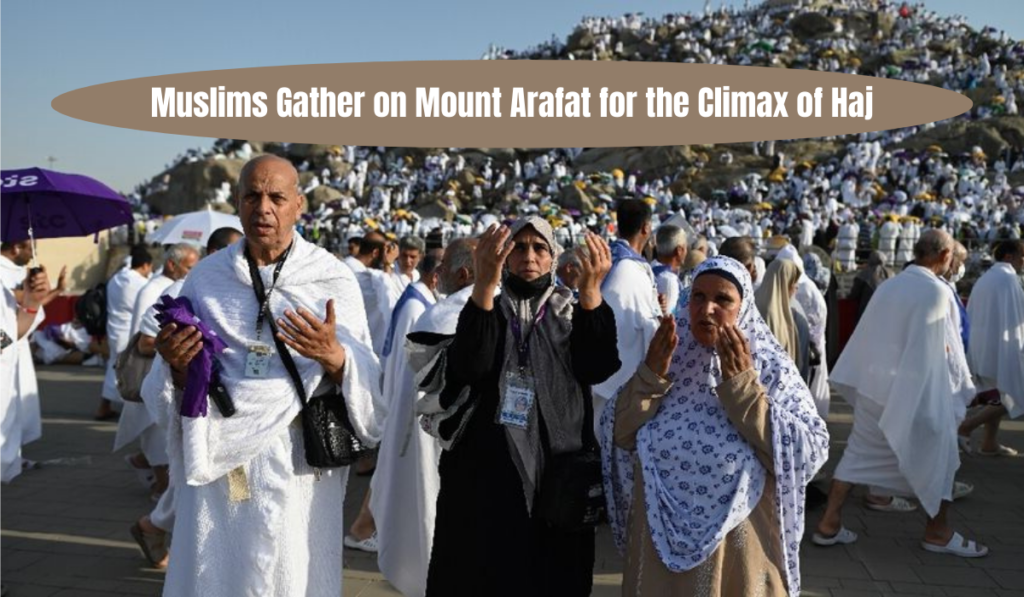Introduction
On Saturday, over 1.5 million Muslims gathered at Mount Arafat for the most important part of the annual Hajj pilgrimage. Despite the scorching heat, pilgrims from around the world came together to pray, especially for the Palestinians suffering in Gaza.
The Significance of Mount Arafat
What Happens Here?
- Mount Arafat is a 70-meter rocky hill where Prophet Muhammad (Peace Be Upon Him) gave his final sermon.
- Pilgrims arrive dressed in white to symbolize purity and equality.
- It’s the most challenging day of the pilgrimage, known as the “Day of Arafat.”
Pilgrims’ Perspective
- Mohamed Asser, a 46-year-old Egyptian, emphasized the importance of this day and mentioned he had a list of prayers, including ones for Palestinians.
Context of Current Events
Conflict in Gaza
- This year’s Hajj coincides with ongoing conflict in Gaza between Israel and Hamas.
- The fighting began with a Hamas attack on southern Israel on October 7, leading to casualties on both sides.
Casualty Figures
- According to Israeli officials, 1,194 people, mostly civilians, have died due to the initial attack.
- Gaza’s health ministry reports at least 37,266 people, also mostly civilians, have died from Israel’s subsequent military actions.
Regulations and Pilgrim Reactions
Political Activity Restrictions
- Saudi Arabia’s minister for religious pilgrimages, Tawfiq al-Rabiah, warned against political activities during Hajj.
- Despite this, some pilgrims voiced support for Palestinians. One was heard chanting for victory for Muslims in Palestine and Gaza.
Global Support
- Iranian leader Ayatollah Ali Khamenei expressed support for Gaza, urging full backing for Palestinians in a message to pilgrims.
Climate Challenges During Hajj
Rising Temperatures
- A recent Saudi study indicates that temperatures in the region are increasing by 0.4°C every decade.
- Pilgrims are advised to stay hydrated and shield themselves from the sun.
Pilgrims’ Experience
- Abraman Hawa from Ghana mentioned the intense heat but remained committed to praying at Arafat.
- Mustafa, an Algerian pilgrim, relied on an umbrella provided by Hajj organizers to cope with the heat.
- A 33-year-old Indian pilgrim, Ahmad Karim Abdelsalam, used water sprays and an umbrella to manage the heat, expressing initial fears about the hours on Mount Arafat.
Moving Forward
Post-Arafat Rituals
- After Mount Arafat, pilgrims move to Muzdalifah to gather pebbles.
- These pebbles are used in the symbolic “stoning of the devil” ritual in Mina.
Importance of Hajj
Religious and Economic Significance
- Hajj is one of the five pillars of Islam, a mandatory act of worship for Muslims who can afford it.
- It is also vital for Saudi Arabia’s religious tourism, contributing to the economy beyond oil revenues.
- Last year, over 1.8 million pilgrims attended Hajj, with 90% from abroad. The kingdom aims to welcome 30 million pilgrims annually by 2030.
Conclusion
Hajj is not just a journey of faith but also a moment of solidarity, reflection, and coping with current challenges. Despite the difficulties, the commitment of pilgrims to this sacred duty remains strong.
Despite the logistical, physical, and emotional challenges that accompany the journey—such as the demanding rituals, the intense crowds, and the often harsh environmental conditions—the dedication of the pilgrims to fulfilling this religious obligation remains resolute. The commitment to Hajj reflects not only a personal resolve but also a broader sense of communal responsibility and spiritual fulfillment.
The resilience and devotion demonstrated by those undertaking the pilgrimage highlight the profound significance of Hajj in the lives of Muslims. It is a testament to their enduring faith and determination to uphold this important aspect of their religious practice, regardless of the obstacles they may encounter.
Table of Contents
References
- AFP, Official Statements on Gaza Conflict Casualties.
- Saudi Ministry of Hajj and Umrah, Annual Pilgrimage Figures and Studies.
- Pilgrims’ Testimonies and On-Ground Reports.
This structured approach aims to simplify the original article while retaining its key details and significance.

